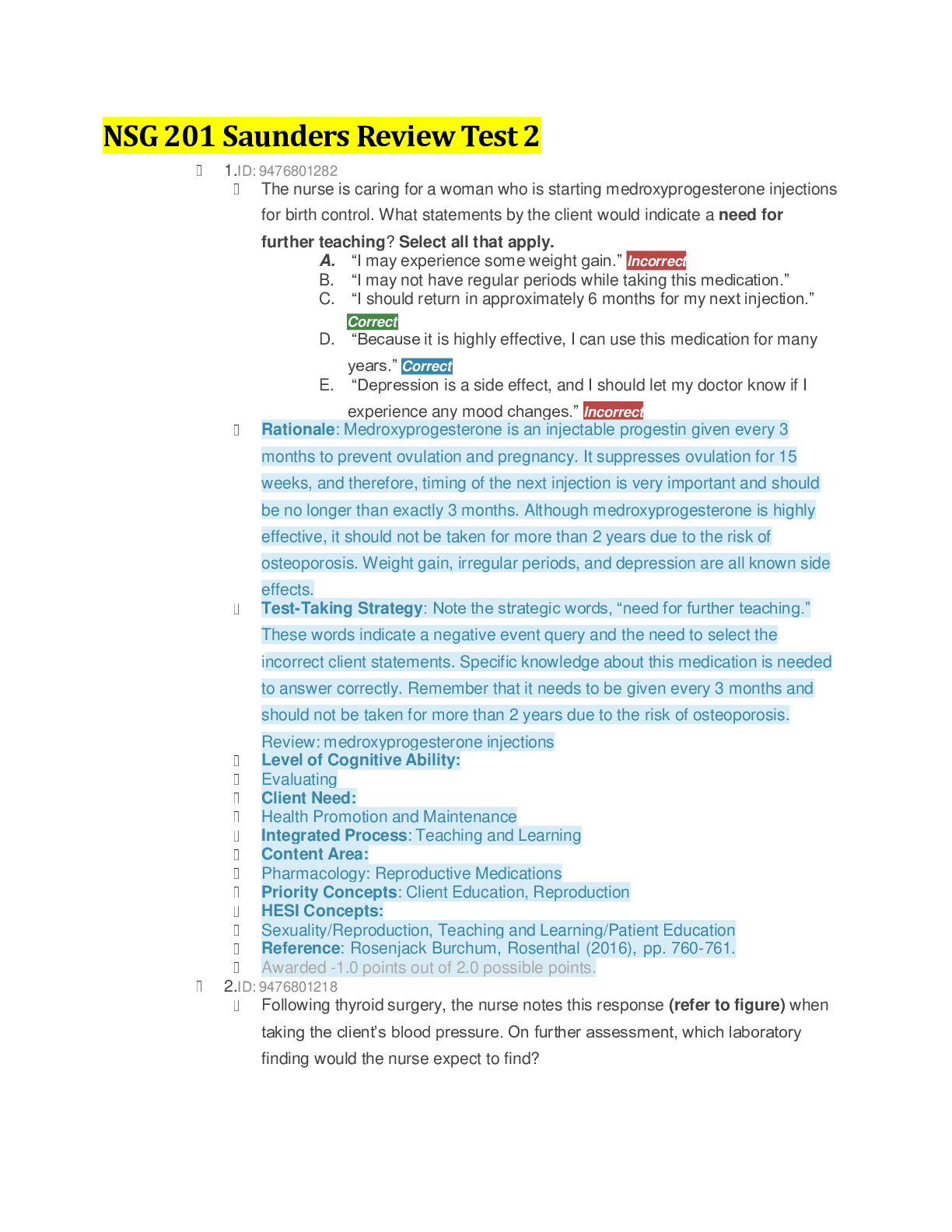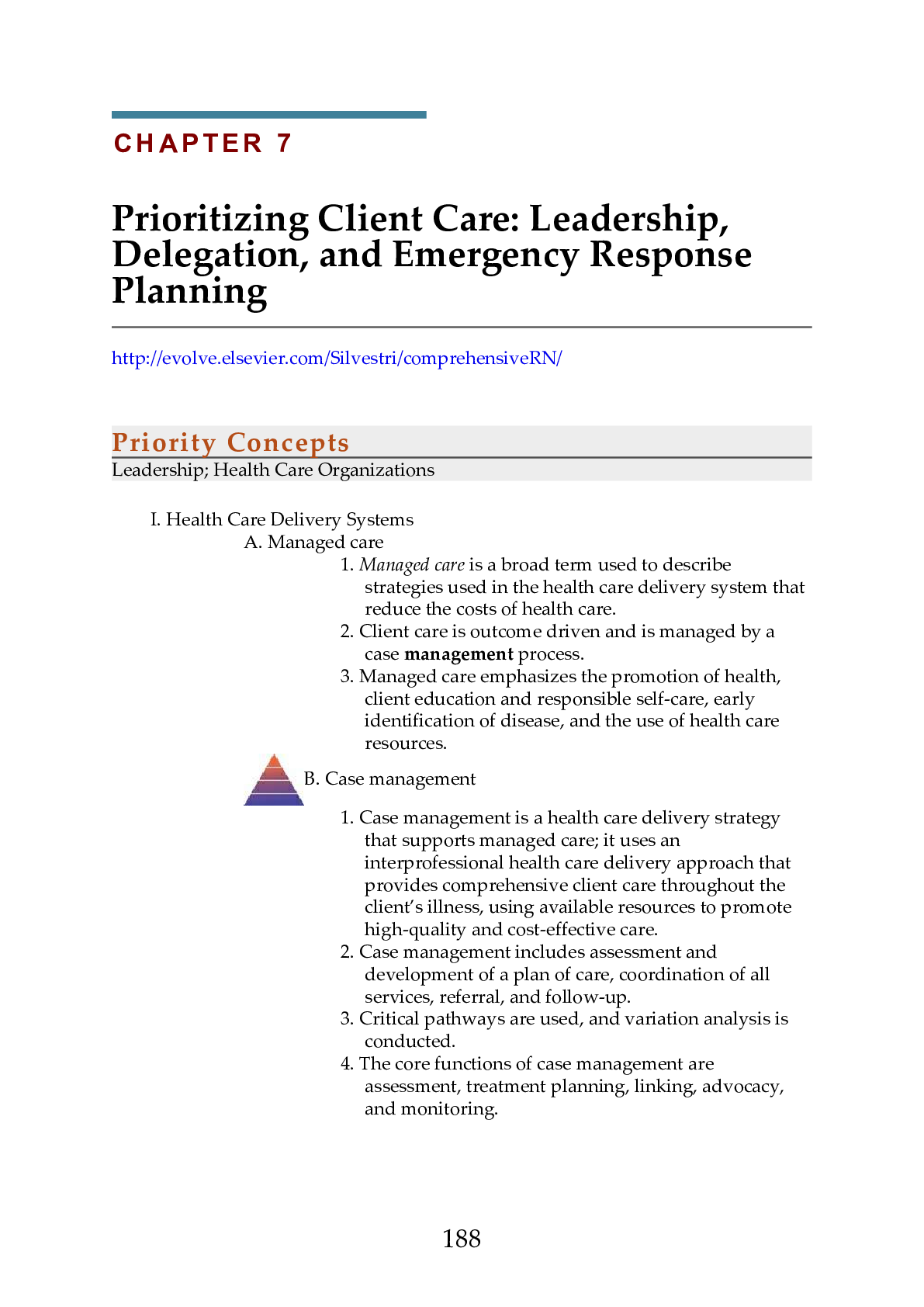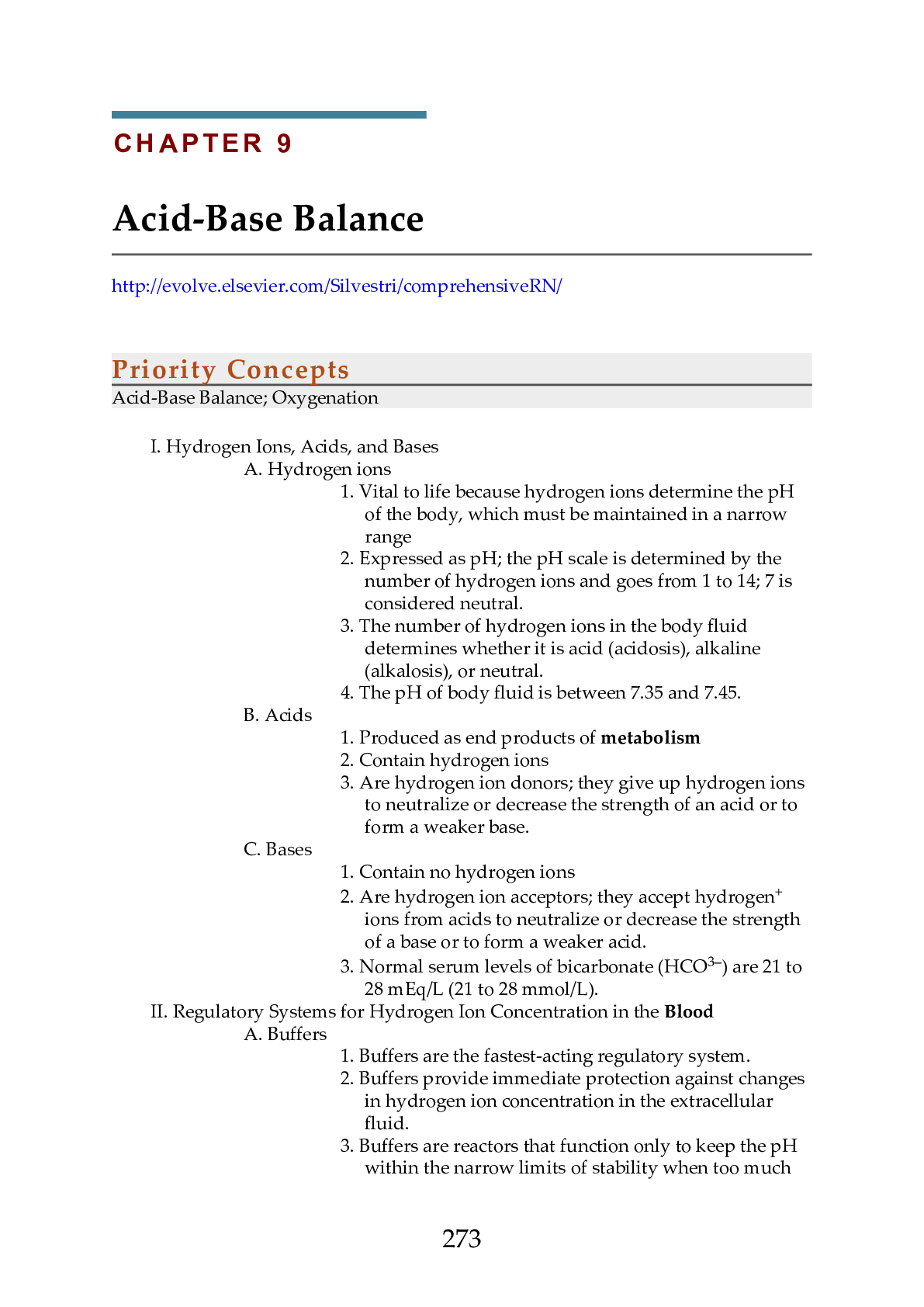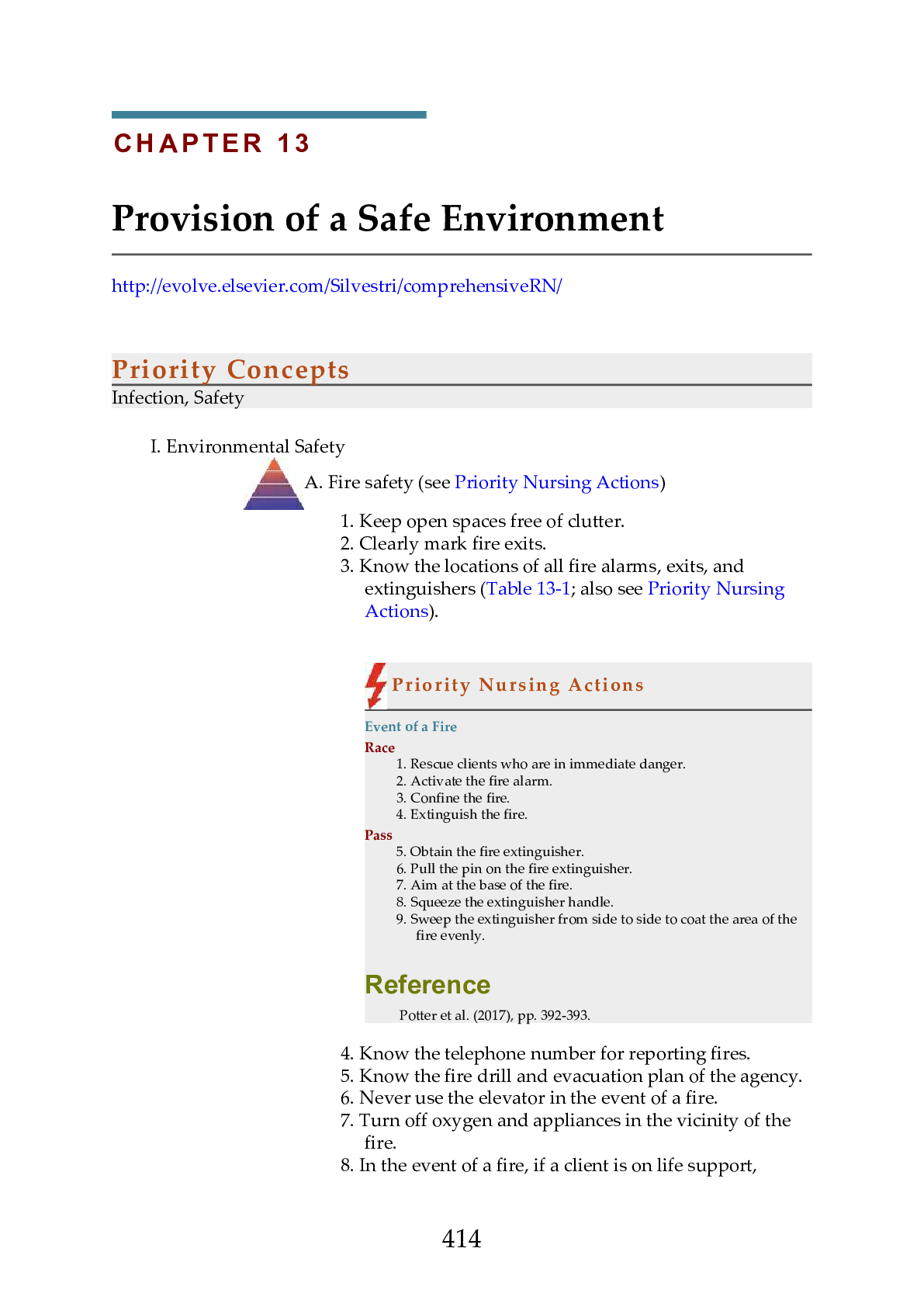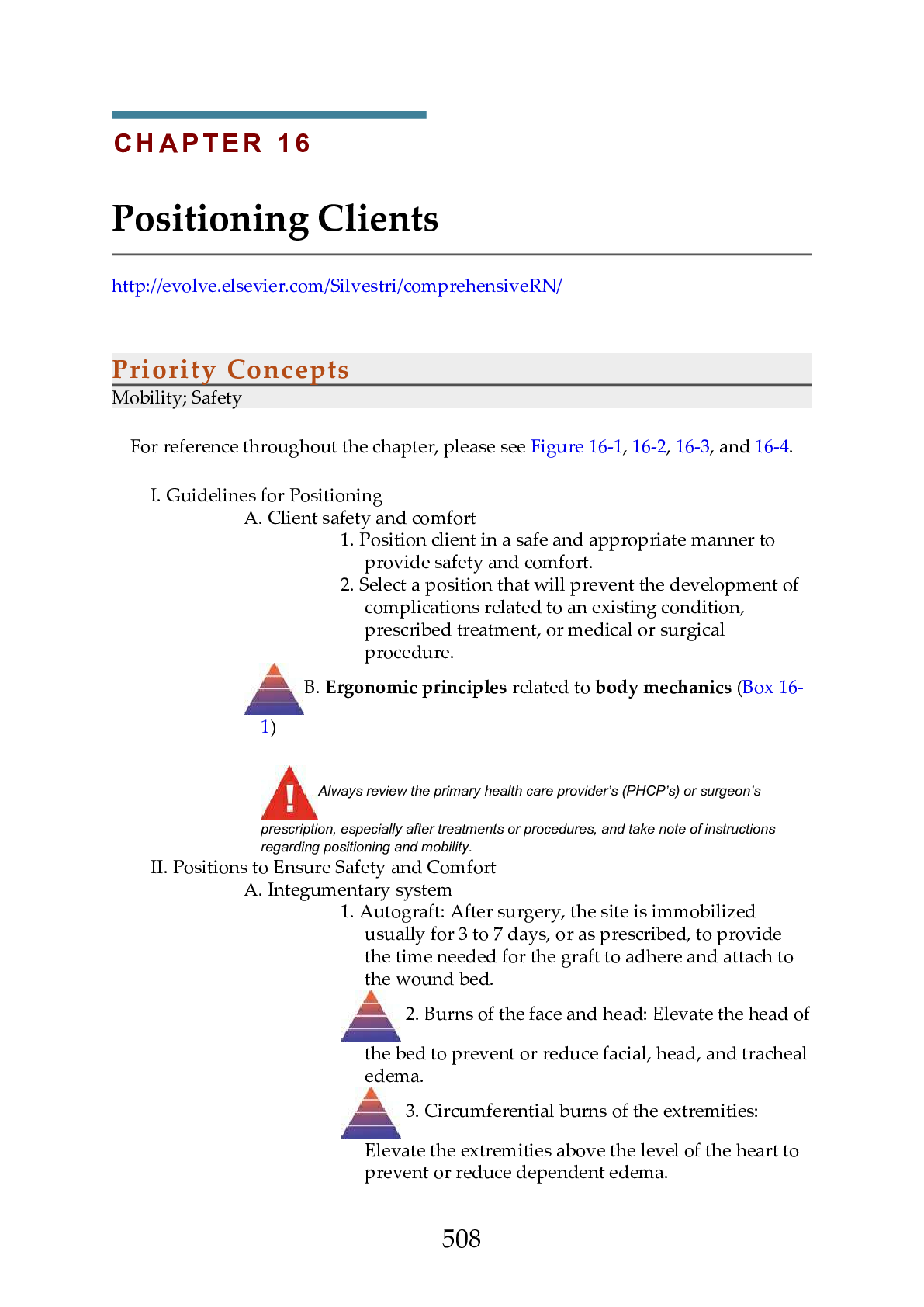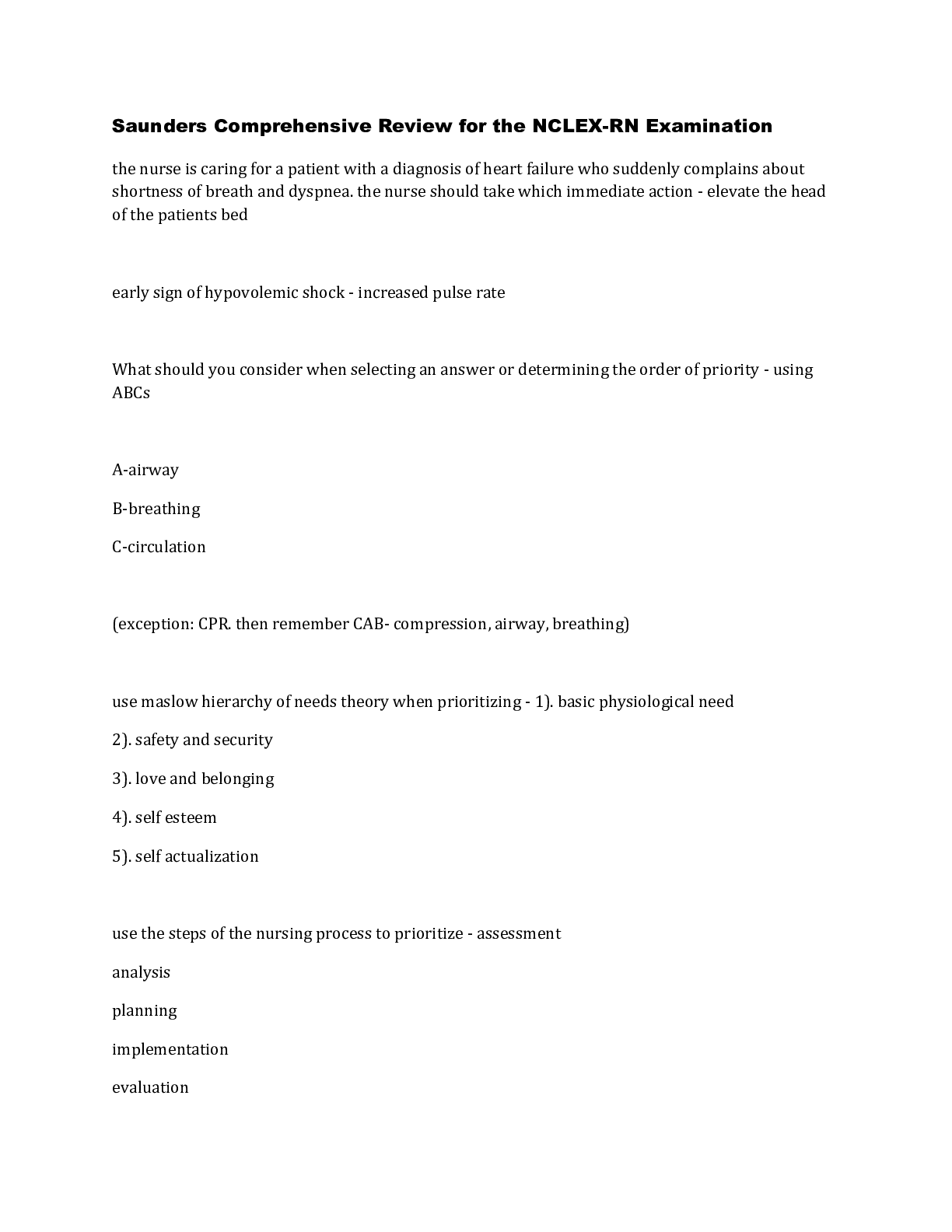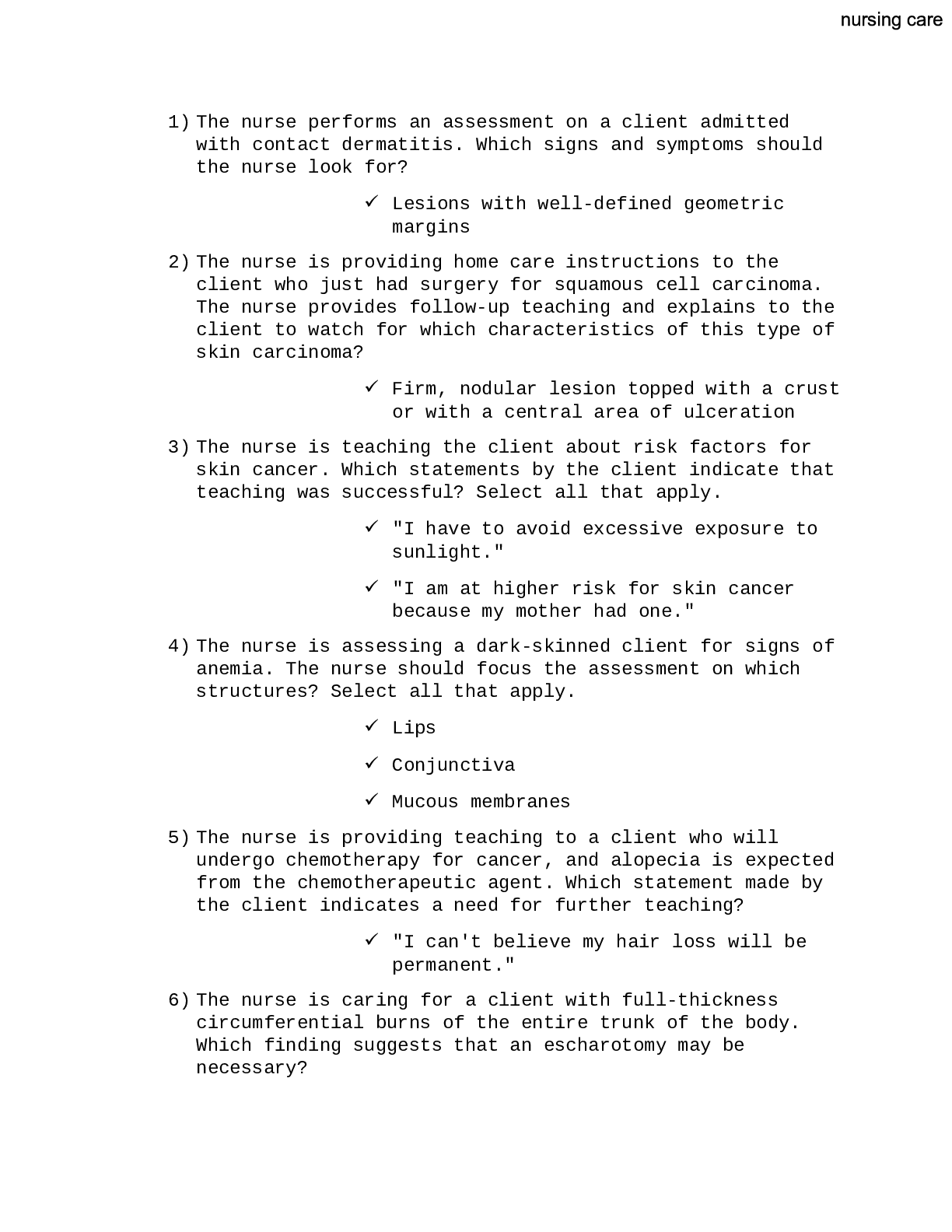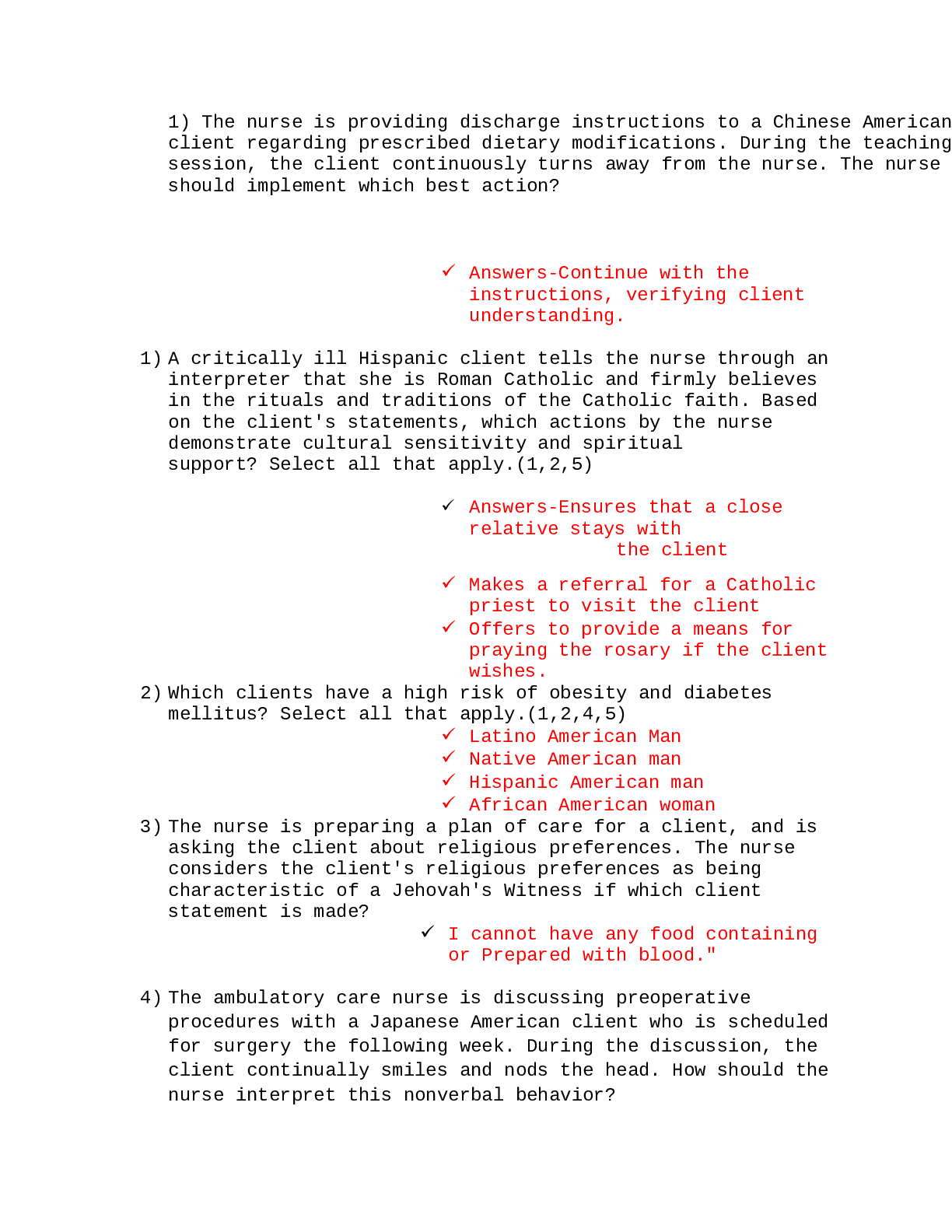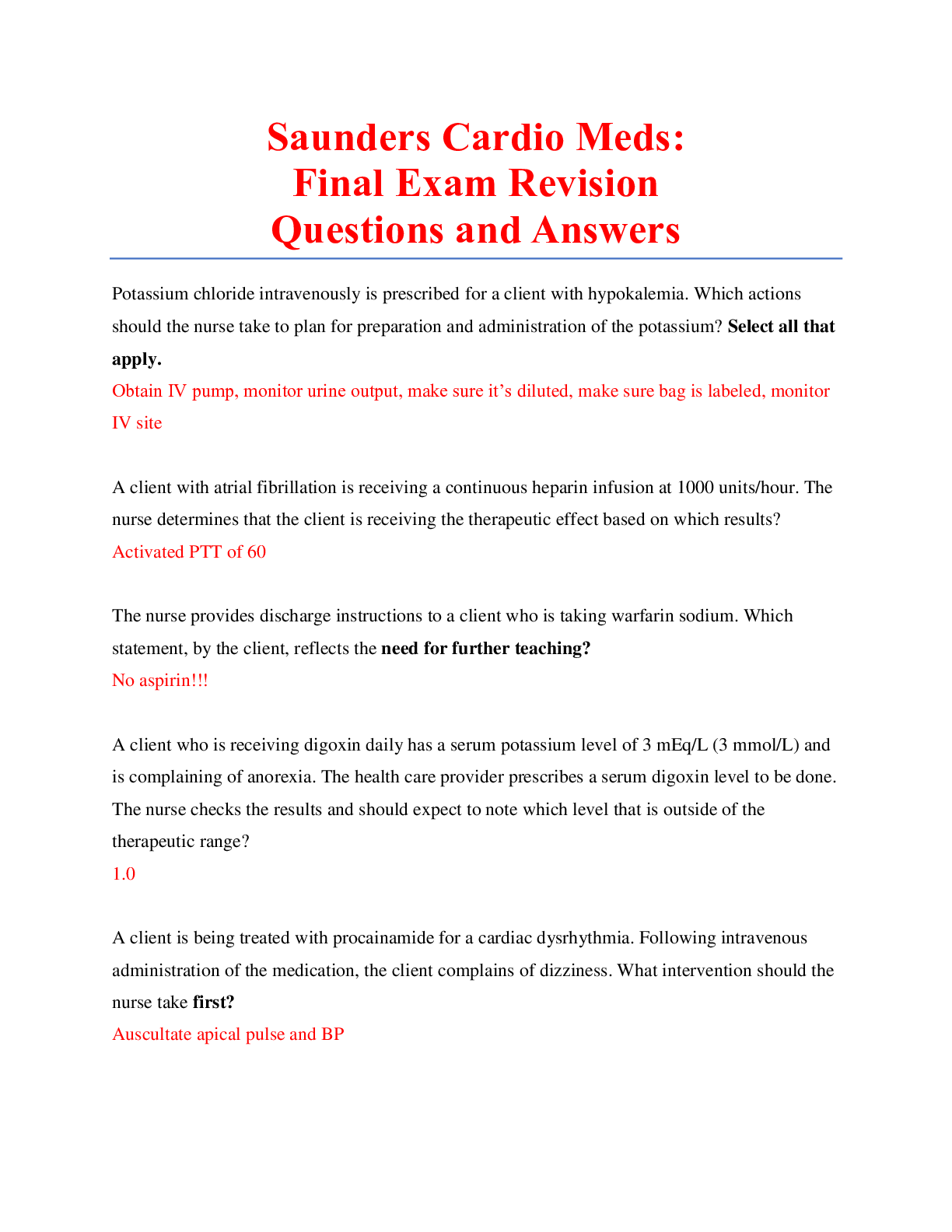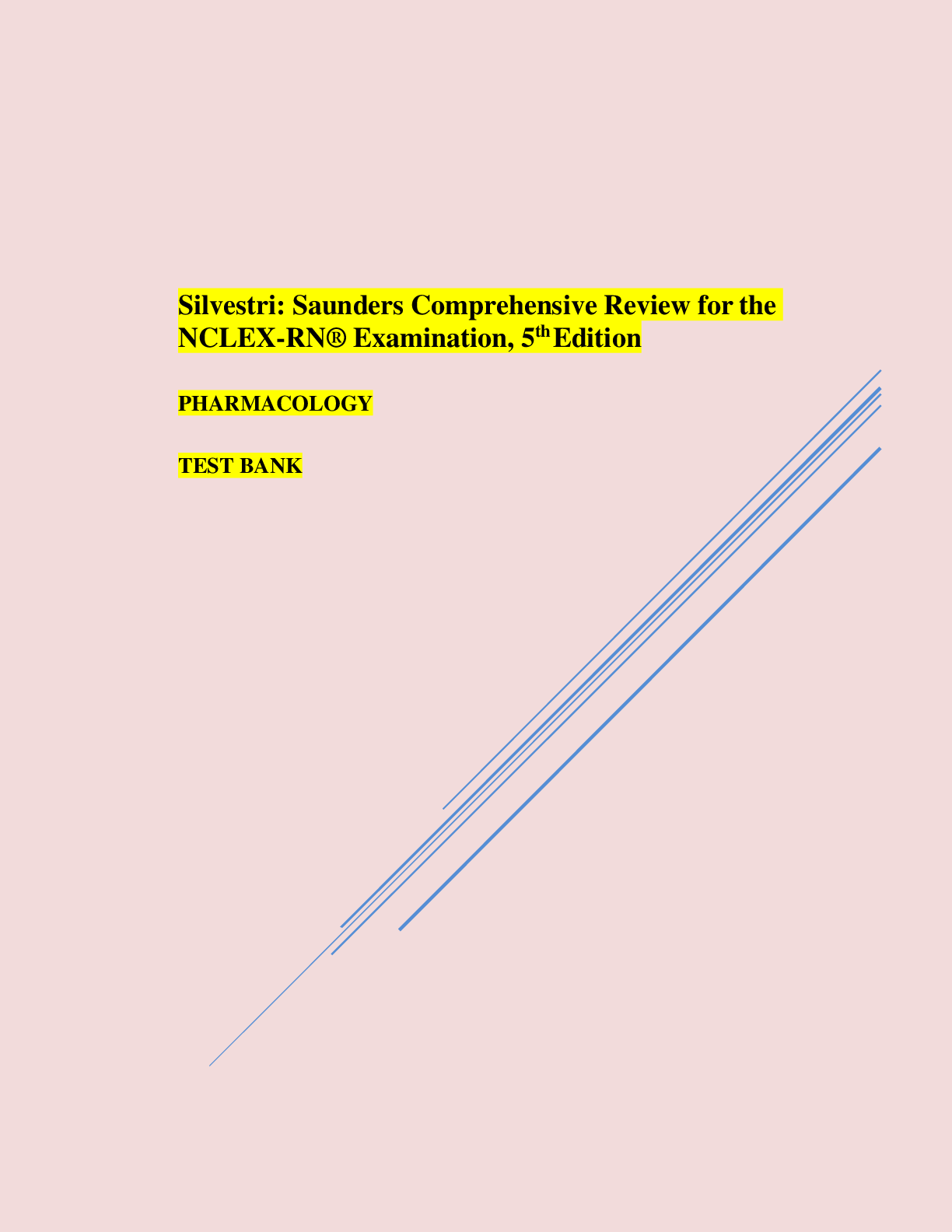*NURSING > NCLEX-RN > C H A P T E R 5: Care of Special Populations: From Saunders Comprehensive Review for the NCLEX-RN E (All)
C H A P T E R 5: Care of Special Populations: From Saunders Comprehensive Review for the NCLEX-RN Examination 8th Edition. (Available: https://bit.ly/2HeJuMt ). Contains Practice questions and Answers with the Rationale, Test-Taking Strategy, Level of Cognitive Ability, Client Needs, Integrated Process, Content Area, Health Problem, Priority Concepts and Reference.
Document Content and Description Below
Priority Concepts Caregiving, Health Disparities I. Special Population Groups A. The literature identifies numerous groups that may be designated as a special population group. B. For this chapte... r, the authors have identified certain special groups that would most commonly be encountered in the health care environment and require sensitivity regarding their health care needs. C. Vulnerable groups typically experience health disparities and inequalities and include people of color, those who are uninsured, those living in poverty or homeless, those with chronic illness or disabilities, immigrants, refugees, those with limited English proficiency, those who are incarcerated, and members of the LGBTQ (lesbian, gay, bisexual, transgender, queer or questioning) community. D. See Box 5-1 for a list of special populations. E. See Box 5-2 for a comprehensive nursing assessment tool written by the authors of this chapter, titled Special Populations Needs Assessment Tool, that can be used to obtain information from the client about his or her special needs in order to plan care. This tool can be adapted, based on the individual being cared for. F. Health care providers’ self-awareness of their own culture, values, beliefs, ethics, personality, and communication style promotes optimal health outcomes for clients of diverse cultures. Recognizing one’s own biases or prejudices and being respectful to all people despite differences can influence satisfaction of care. An encounter with a client should elicit the client’s unique perspectives based on their cultural preferences because it will allow the nurse to understand what health care treatment will be realistic and acceptable. G. It is imperative for health care providers to understand that cultural groups share dominant characteristic however subcultures exist and stereotyping must be avoided. 119II. Racial and Ethnic Minorities A. Due to the increasing diversity of the United States population, minorities are projected to become the majority. B. Racial and ethnic minorities are affected more often than their white counterparts by health care disparities and inequalities. C. Social determinants of health are conditions in which persons are born, grow, live, work, and age, including the health care system, and are correlated with health and health inequities. D. Cultural competence is a necessary ability for health care professionals to provide care for a diverse population and can help improve health outcomes and quality of care. E. Family members and friends should not be asked to be an interpreter for the client because of confidentiality, the potential for conflict of interest, and the risk associated with relaying inaccurate information; only specified individuals as designated by the health care agency should be asked to interpret for a client. F. Return explanation and demonstration (teach-back) are of particular importance when working with clients of various backgrounds to ensure safety and mutual understanding. Some ethnic minorities report hesitancy in seeking health care due to a language barrier. Ineffective communication between the health care provider and the client can affect client safety or the client’s ability to comply with follow-up care. G. Description and population-based risk factors 1. African Americans or Blacks a. This population has origins in Africa and the Caribbean. b. Some in this population may be less likely to have health insurance coverage or a regular source of health care. c. Nearly 50% of adults have chronic health conditions. For additional information, refer to https://cdn.americanprogress.org/wpcontent/uploads/issues/2010/12/pdf/disparities_factsh d. Obesity, diabetes mellitus, hypertension, heart disease, asthma, and cancer are prevalent among this population. e. Some leading causes of death among this population are heart disease, cancer, and stroke. 2. Hispanics/Latinos a. This population has origins in Mexico, 1. Which teaching method is most effective when providing instruction to members of special populations? 1. Teach-back 2. Video instruction 3. Written materials 4. Verbal explanation 2. Which health concern(s) should the nurse be aware of as risk factors when caring for clients of African American descent? Select all that apply. 1. Cancer 2. Obesity 3. Hypertension 4. Heart disease 5. Hypothyroidism 6. Diabetes mellitus 3. The nurse is planning care for a client of Native Hawaiian descent who recently had a baby. The nurse develops a teaching plan and includes information about which measure that is related to a newborn complication within this ethnic group? 1. Safe sleeping 2. Car seat safety 3. Breast-feeding 4. Baby-proofing 4. The nurse is planning care for an assigned client. The nurse should include information in the plan of care about prevention of human immunodeficiency virus (HIV) for which individuals specifically at risk? 1. Lesbian persons 2. Men-who-have-sex-with-men (MSM) 3. Women-who-have-sex-with-women (WSW) 1434. Female-to-male (FTM) transgender persons 5. Which therapeutic communication technique is most helpful when working with transgender persons? 1. Using open-ended questions 2. Using their first name to address them 3. Using pronouns associated with birth sex 4. Anticipating the client’s needs and making suggestions 6. Which special population should be targeted for breast cancer screening by way of mammography? Select all that apply. 1. Male-to-female (MTF) 2. Female-to-male (FTM) 3. Men-who-have-sex-with-men (MSM) 4. Women-who-have-sex-with-men (WSM) 5. Women-who-have-sex-with-women (WSW) 7. The nurse is volunteering with an outreach program to provide basic health care for homeless people. Which finding, if noted, should be addressed first? 1. Blood pressure 154/72 mm Hg 2. Visual acuity of 20/200 in both eyes 3. Random blood glucose level of 206 mg/dL (11.47 mmol/L) 4. Complaints of pain associated with numbness and tingling in both feet 8. The nurse is preparing discharge resources for a client being discharged to the homeless shelter. When looking at the discharge medication reconciliation form, the nurse determines there is a need for follow-up if which medication was prescribed? 1. Glipizide 2. Lisinopril 3. Metformin 4. Beclomethasone 9. The nurse is completing the admission assessment for a client who is intellectually disabled. Which part of the client encounter may require more time to complete? 1. The history 2. The physical assessment 3. The nursing plan of care 4. The readmission risk assessment 10. The nurse working in a correctional facility is caring for a new prisoner. The client asks about health risks associated with living in a prison. How should the nurse respond? 1. “Health care is very limited in the prison setting.” 2. “Living in a prison isn’t different than living at home.” 3. “Living in a prison can predispose a person to different health conditions.” 4. “Living in a prison is similar to living in a condominium complex or dormitory.” 14411. The nurse is caring for a female client in the emergency department who presents with a complaint of fatigue and shortness of breath. Which physical assessment findings, if noted by the nurse, warrant a need for follow-up? 1. Reddened sclera of the eyes 2. Dry flaking noted on the scalp 3. A reddish-purple mark on the neck 4. A scaly rash noted on the elbows and knees 12. The nurse working in a community outreach program for foster children plans care knowing that which health conditions are common in this population? Select all that apply. 1. Asthma 2. Claustrophobia 3. Sleep problems 4. Bipolar disorder 5. Aggressive behavior 6. Attention-deficit hyperactivity disorder (ADHD) 13. The nurse planning care for a military veteran should prioritize nursing interventions targeted at managing which condition, if present, that commonly occurs in this population? 1. Hypertension 2. Hyperlipidemia 3. Substance abuse disorder 4. Post-traumatic stress disorder 14. The nurse caring for a refugee considers which health care need a priority for this client? 1. Access to housing 2. Access to clean water 3. Access to transportation 4. Access to mental health care services 15. Which action by the nurse will best facilitate adherence to the treatment regimen for a client with a chronic illness? 1. Arranging for home health care 2. Focusing on managing a single illness at a time 3. Communicating with one provider only to avoid confusion for the client 4. Allowing the client to teach a support person about their treatment reg [Show More]
Last updated: 1 year ago
Preview 1 out of 34 pages
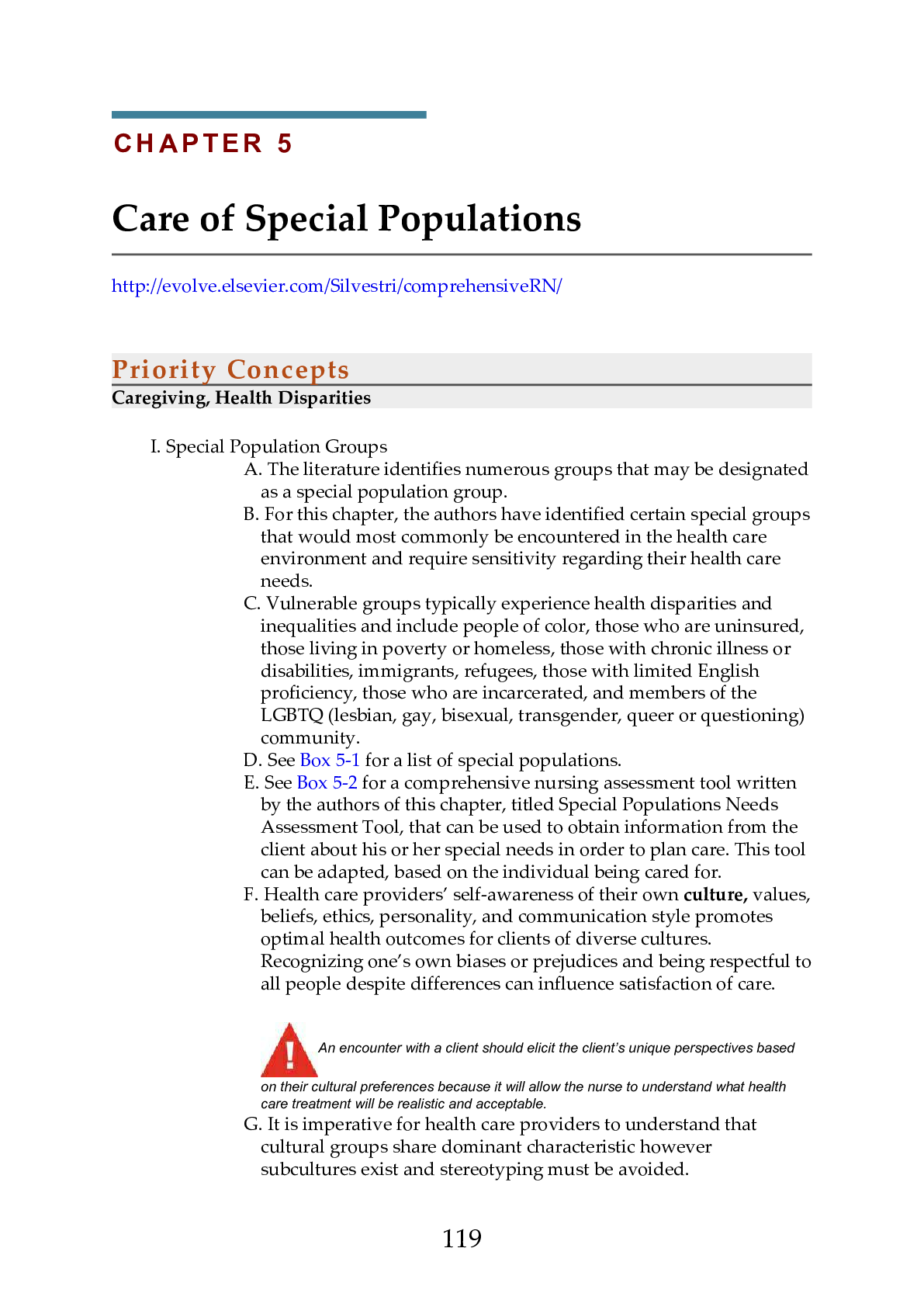
Reviews( 0 )
Document information
Connected school, study & course
About the document
Uploaded On
Oct 22, 2020
Number of pages
34
Written in
Additional information
This document has been written for:
Uploaded
Oct 22, 2020
Downloads
0
Views
101


